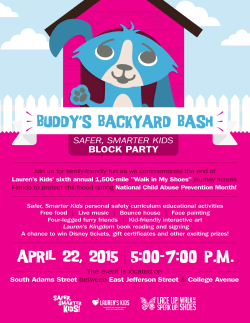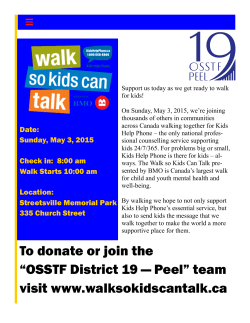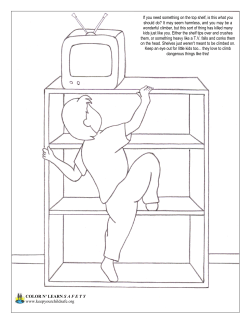
PDF - T. Rowe Price
VOLUNTEERS’ EDITION A supplement to Junior Scholastic ® presented by Supplement to Scholastic Magazines. SCHOLASTIC and associated logos are trademarks and/or registered trademarks of Scholastic Inc. All rights reserved. 0-545-84918-7 MONEY CONFIDENT KIDS is a registered trademark of T. Rowe Price Group, Inc., 2014-US-6695 DEAR VOLUNTEER, Welcome to this special supplement to Junior Scholastic from T. Rowe Price. This edition is designed for kids in grades 5–8 as an easy-to-use tool to help you show kids how to make well-informed financial decisions. Here’s how it works: 1. Read the lesson instructions and the student magazine at www.scholastic.com/MCK. 2. Depending on your interest and how much time you have in the classroom, choose the activity you will share. 3. Have fun! If you’re having fun and are interested in what you’re talking about, students will be too. We hope that these materials will provide a catalyst for interesting discussions about making wise spending choices. Enjoy! Additional Online Resources www.scholastic.com/MCK Here are additional resources that you may find useful during your classroom visits: DOWNLOADABLE PDFs • Money Confident Kids student magazine • Language of Money glossary • Costly Crossword puzzle • Amazing Money Maze activity • Spending Tracker tool STAR banks adventure Engage students in this exciting game that teaches positive financial behaviors. Resources • 30 Days of Financial Fitness family activity VIDEOS • “What Kids Say About Money” videos This Volunteer Guide and the Money Confident Kids magazine are also available at www.scholastic.com/MCK Activity A: spend now, spend later GOAL: Through a lively classroom activity, help students understand that “saving” is really just planning to spend later. MATERIALS (30 copies of each): Money Confident Kids student magazine, statistics chart TIME FRAME: Approximately 40 minutes (one class period) Target grades: 5–8 ICEBREAKER 1. Write the words “save” and “spend” on the board. 2. Ask students whether they feel that either one of these concepts is better than the other. Opinions on this question will vary, but encourage a short conversation without expressing your own feelings. Take a quick vote to find out what percentage of the class feels spending is “better” than saving. Draw a pie chart on the board to show what you discovered so students can refer to it later. 3. Cross out the words “spend” and “save” on the board and replace them with the words “spend now” and “spend later.” Explain that from now on you’d like them to stop thinking of money in two buckets— spending and saving. Tell them it’s really all spending. The difference is whether you’re planning to spend now or spend later. Activity C: Personal goals GOAL: Help students identify a goal and develop a financial plan. MATERIALS (30 copies of each): Money Confident Kids student magazine including “Getting to Your Goal” on the last page of this booklet, Star Banks Adventure TIME FRAME: Approximately 40 minutes (one class period) Target grades: 5–8 activity ENTERTAINMENT ORDER TIME $60.00 2 WEEKS AHEAD Rock climbing course $100.00 4 WEEKS AHEAD • Share the most challenging spending choice you’ve had to make. Fencing instructor $100.00 2 WEEKS AHEAD Spa makeover $120.00 4 WEEKS AHEAD • Give students the option to share their own spending and saving challenges and concerns. Most teen goals are a combination of short-term wants, like having some cash for a movie, and long-term desires, like saving for college or buying a car. GOODIE BAGS • Talk about the satisfaction of buying right away and also reinforce the excitement of getting ready to make a big purchase like a used car, concert tickets, or a racing bike. You can see your money grow, and anticipating your purchase gives you time to make sure you’re getting the best deal. Stupendous bag 4. T alk with students about your own experiences with spending now and spending later. You can: 5. S eparate students into three to five teams and present the following challenge: DJ and dance floor COST PER ITEM COST PER ITEM $37.50 DAY BEFORE PARTY Great bag $75.00 DAY BEFORE PARTY Amazing bag $90.00 DAY BEFORE PARTY 5 WEEKS AHEAD Show me how you will make decisions and trade-offs to spend my money over the next eight weeks and give me a party that will knock my kid’s socks off! 6. T here are many possible solutions to this challenge. Ask students to share their reasoning and follow up with the following questions: I want to throw an amazing birthday party for my fifth grader but I don’t have time to plan it. So, I’d like each team to present an exciting party plan to me. • Did anyone choose the Stupendous bag? Why or why not? (No, they didn’t have $150 five weeks before the party.) Here’s the challenge: I will pay you $25 every week for eight weeks until the party. You need to make choices from the following list that fit within my budget. • Could you order a themed lunch for the Spa makeover party? Why or why not? (No, the payment timing does not work out.) Wrap-up FOOD COST PER ITEM ORDER TIME 3D decorated cake $75.00 4 WEEKS AHEAD Simple cake $40.00 2 WEEKS AHEAD Chips $7.50 1 WEEK AHEAD Soda $7.50 1 WEEK AHEAD Themed lunch, buffet-style $90.00 5 WEEKS AHEAD Ask students whether their opinion about spending and saving has changed. We hope that students will feel that the idea of spending now and spending later is more positive and proactive. Leave behind a copy of the Money Confident Kids magazine for each student. TIME You can shorten this lesson by doing the activity as a group. SPECIAL NOTE: This activity requires computer access for each student (or student group). Be sure to check with the teacher before planning this lesson. ICEBREAKER 1. B rainstorm a list of things that students would like to be able to buy for themselves. Items should be a mixture of things that they can see themselves owning within two years (short-term), things they might want in 2–15 years (medium-term), and things that are 15-plus years on the horizon (long-term). activity 2. H ave students use the T. Rowe Price game, Star Banks Adventure, to practice setting goals! Separate students into pairs or small groups so that each student has access to a computer. Teen Spending ORDER TIME Fun bag $150.00 Activity B: 3. Ask all students to go to www.tktk.com and instruct them to set a goal and play the first level of the game. At the end of level one, talk to the students about who did a “trade-off” and purchased a cheaper version of their goal (i.e., bought a used bike instead of a new one) and why. 4. Look at the “Getting to Your Goal” infographic on the back of Money Confident Kids magazine. Help students apply what they learned in Star Banks Adventure to their own personal spending goals. Wrap-up Distribute copies of Money Confident Kids magazine for students to take home. TIME You can shorten this lesson by distributing the Money Confident Kids magazine for students to read at home. GOAL: Help students analyze their own spending habits. MATERIALS (30 copies of each): Money Confident Kids student magazine, “The Power of Advertising” worksheet, photographs available here TIME FRAME: Approximately 40 minutes (one class period) Target grades: 5–8 ICEBREAKER 1. Ask students what they think the average teen spends his or her own money on. Make a list on the board, then ask students to rank them from “most popular” to “least popular.” ACTIVITY 2. S eparate students into pairs and give each a copy of “The Power of Advertising” student worksheet (on the back page of this Volunteers’ Edition). Explain that they are going to be doing some simple observational research. 3. U sing a tablet or printouts, ask pairs to carefully observe the photographs (available here) as they complete the worksheet together. 4. C ome together and discuss the observations and whether those observations will have an impact on the way that students will shop in the future. Wrap-up Explain that retailers use a variety of marketing strategies to get people to spend their money now instead of later. Impulse buys are purchases that are made for immediate enjoyment, like a candy bar at the checkout, a T-shirt at a concert, or an extra snack at the movie theater. They are not planned purchases. Approximately 40% of all purchases are impulse buys, so encourage students to think carefully about their long-term goals before spending on an impulse. Leave behind a copy of Money Confident Kids magazine for each student. TIME You can shorten this lesson by doing the observation as a full group. NAME: The Power of Advertising Retailers have lots of ways to try to get people to spend their money now instead of later. Spend 10 minutes observing carefully. Fill in this chart to help you remember what you saw. Store Environment 1. Do you see signs that promote impulse purchases? Describe them. 2. Is the merchandise arranged in a way that promotes impulse purchases (such as small items near the cash register)? Describe it. Customers 1. How many customers do you see? 2. Are any customers making a purchase? Do you think others will? Why or why not? 3. Do you think customers were making impulse purchases? Why or why not? 4. Would you be tempted to buy something at the stores? Why or why not? Did anything surprise you?
© Copyright 2025









